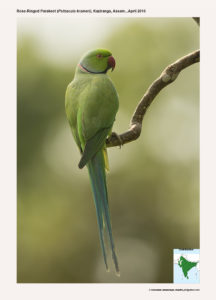
Rose-ringed Parakeet Psittacula krameri
Etymology:
- Psittacula : Latin word derived from psittacus – Parrot
- Krameri : Named after Austrian naturalist Wilhelm Heinrich Kramer (d. 1765)
Vernacular names: Pakistan: Gallar, Sind: Chatun, Hindi: Lybartota, Swa, Suva, Pun: Tota, Sugga, Ben: Tiyatota, Ass: Bhatovsorai, Cachar: Daobator, Nepal: Tenthiasuga,Guj: Popat, Sudo, chiluka, Mar: Popat, Keera, Ori: For parakeets – Shua, Ta: For parakeets – Kili, Te: Rama chiluka, Mal: Tatta, Modirattatta, Kan: Kempupattegini, Sinh: Rannagirawa
Distribution in India: Resident of peninsular India
Description: Size of 37–43 cm; wt. of 95–143 g. It is pale yellowish green, with dark upper mandible that is red and tipped black, while the lower beak is black. It has a black chin and malar area curving and narrowing into half-collar on side of neck, and bordered below by a narrow rose pink line that extends over nape .It has indistinct mauve-blue colour above the nape extending onto hindcrown. The flight-feathers are duskier green above, grey below. The tail is bluish green on central feathers, ocher below. The female lacks blue, pink and black on head but can show emerald collar. The immature is like female but yellower, with no or indistinct collar.
Habitat: It is found in deciduous habitats ranging from semi-desert to light secondary jungle, short-grass and semi-desert savanna, open scrub and bush land, wooded valleys, savanna woodland, riparian and evergreen forest, foothill pine zone, open agricultural land with scattered trees, gardens, orchards, cultivation, often also grain yards at railway stations. It is found from Lowlands up to 2000 m.
Food habits :
It eats fruits,cultivated seeds and nuts, flowers, flower petals and nectar.In Asia, especially India, regarded as one of the most destructive bird pests in agriculture, coming in enormous flocks to cereals and fruit crops.
Breeding habits: They breed in Dec–May in W Africa and Arabia,Jan–Jul in Asia and Jan–Jun in UK. The nest is in a hollow in tree, usually enlarged by birds themselves, sometimes in rock faces or ruined walls. They lay a clutch of 3–4 eggs. The incubation period is 22 days and nestling period is 7 weeks.